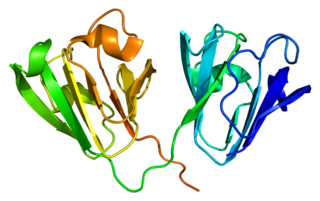Related Research Articles

Leukotriene C4 synthase is an enzyme that in humans is encoded by the LTC4S gene.

Frizzled-2 is a protein that in humans is encoded by the FZD2 gene.

Frizzled-5 is a protein that in humans is encoded by the FZD5 gene.

Frizzled-7 is a protein that in humans is encoded by the FZD7 gene.

Probable G-protein coupled receptor 144 is a protein that in humans is encoded by the GPR144 gene. This gene encodes a member of the adhesion-GPCR family of receptors. Family members are characterised by an extended extracellular region with a variable number of protein domains coupled to a TM7 domain via a domain known as the GPCR-Autoproteolysis INducing (GAIN) domain.

Gamma-crystallin D is a protein that in humans is encoded by the CRYGD gene.

LIM domain-binding protein 1 is a protein that in humans is encoded by the LDB1 gene.

Kinesin-like protein KIF22 is a protein that in humans is encoded by the KIF22 gene.

Rhombotin-1 is a protein that in humans is encoded by the LMO1 gene.

Thyroid hormone receptor-associated protein 3 is a protein that in humans is encoded by the THRAP3 gene.

DNA polymerase delta subunit 2 is an enzyme that in humans is encoded by the POLD2 gene. It is a component of the DNA polymerase delta complex.

Guanine nucleotide-binding protein G(t) subunit alpha-1 is a protein that in humans is encoded by the GNAT1 gene.

Olfactory receptor 6A2 is a protein that in humans is encoded by the OR6A2 gene.

Olfactory receptor 7C1 is a protein that in humans is encoded by the OR7C1 gene.

Olfactory receptor 2A4 is a protein that in humans is encoded by the OR2A4 gene.

Zinc finger protein 44 is a protein that in humans is encoded by the ZNF44 gene.

Kinesin-like protein KIF24 is a protein that in humans is encoded by the KIF24 gene.

Eukaryotic translation initiation factor 1A, Y-chromosomal is a protein that in humans is encoded by the EIF1AY gene.

Alkaline ceramidase 2 also known as ACER2 is a ceramidase enzyme which in humans is encoded by the ACER2 gene.

Guanine nucleotide-binding protein G(t) subunit alpha-3, also known as gustducin alpha-3 chain, is a protein subunit that in humans is encoded by the GNAT3 gene.
References
- 1 2 3 4 Doherty AM, Fisher EM (Sep 2003). "Microcell-mediated chromosome transfer (MMCT): small cells with huge potential". Mamm Genome. 14 (9): 583–92. doi:10.1007/s00335-003-4002-0. PMID 14629108. S2CID 23237145.
- ↑ Sengupta K.; et al. (Feb 2007). "Artificially introduced aneuploid chromosomes assume a conserved position in colon cancer cells". PLOS ONE. 2 (2): e199. Bibcode:2007PLoSO...2..199S. doi: 10.1371/journal.pone.0000199 . PMC 1805818 . PMID 17332847.
- ↑ Fournier RE, Ruddle FH (Jan 1977). "Microcell-mediated transfer of murine chromosomes into mouse, Chinese hamster, and human somatic cells". Proc Natl Acad Sci USA. 74 (1): 319–23. Bibcode:1977PNAS...74..319F. doi: 10.1073/pnas.74.1.319 . PMC 393251 . PMID 264685.
- ↑ Ege T, Ringertz NR (Aug 1974). "Preparation of microcells by enucleation of micronucleate cells". Exp. Cell Res. 87 (2): 378–82. doi:10.1016/0014-4827(74)90494-7. PMID 4370277.
- ↑ Veomett G, Prescott DM, Shay J, Porter KR (May 1974). "Reconstruction of mammalian cells from nuclear and cytoplasmic components separated by treatment with cytochalasin B". Proc Natl Acad Sci USA. 71 (5): 1999–2002. Bibcode:1974PNAS...71.1999V. doi: 10.1073/pnas.71.5.1999 . PMC 388372 . PMID 4525471.
- ↑ Killary AM, Lott ST (Feb 1996). "Production of Microcell Hybrids". Methods. 9 (1): 3–11. doi:10.1006/meth.1996.0002. PMID 9245337.
- ↑ Tomizuka K, Shinohara T, Yoshida H, Uejima H, Ohguma A, Tanaka S, Sato K, Oshimura M, Ishida I (Jan 2000). "Double trans-chromosomic mice: maintenance of two individual human chromosome fragments containing Ig heavy and kappa loci and expression of fully human antibodies". Proc Natl Acad Sci USA. 97 (2): 722–7. Bibcode:2000PNAS...97..722T. doi: 10.1073/pnas.97.2.722 . PMC 15397 . PMID 10639146.
- ↑ Oshimura M, Uno N, Kazuki Y, Katoh M, Inoue T (Feb 2015). "A pathway from chromosome transfer to engineering resulting in human and mouse artificial chromosomes for a variety of applications to bio-medical challenges". Chromosome Res. 23 (1): 111–33. doi:10.1007/s10577-014-9459-z. PMC 4365188 . PMID 25657031.